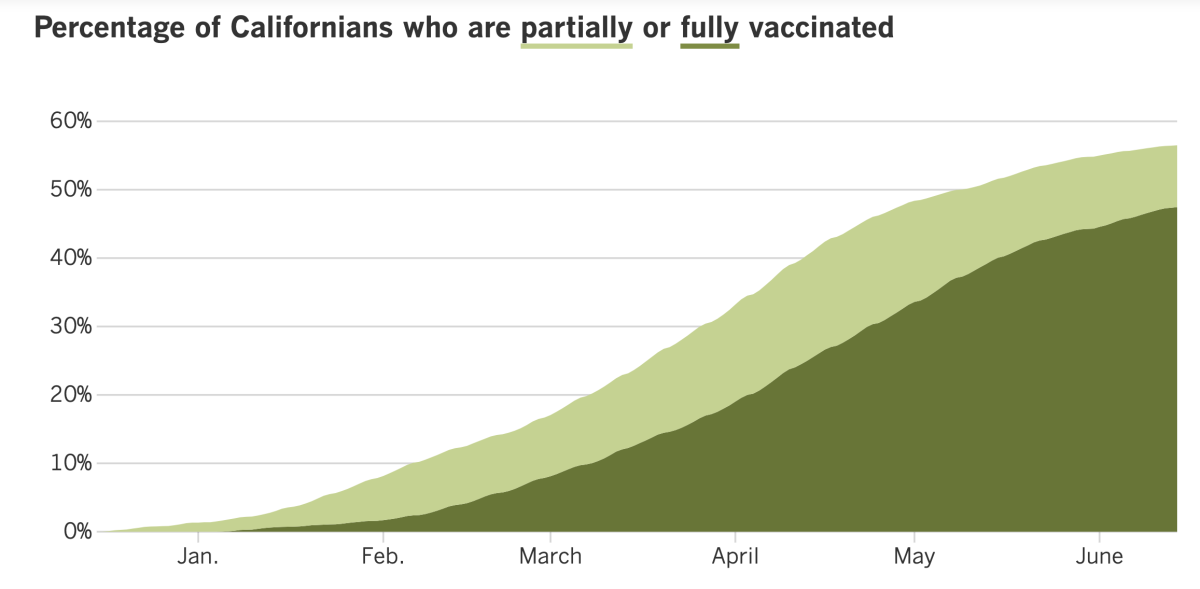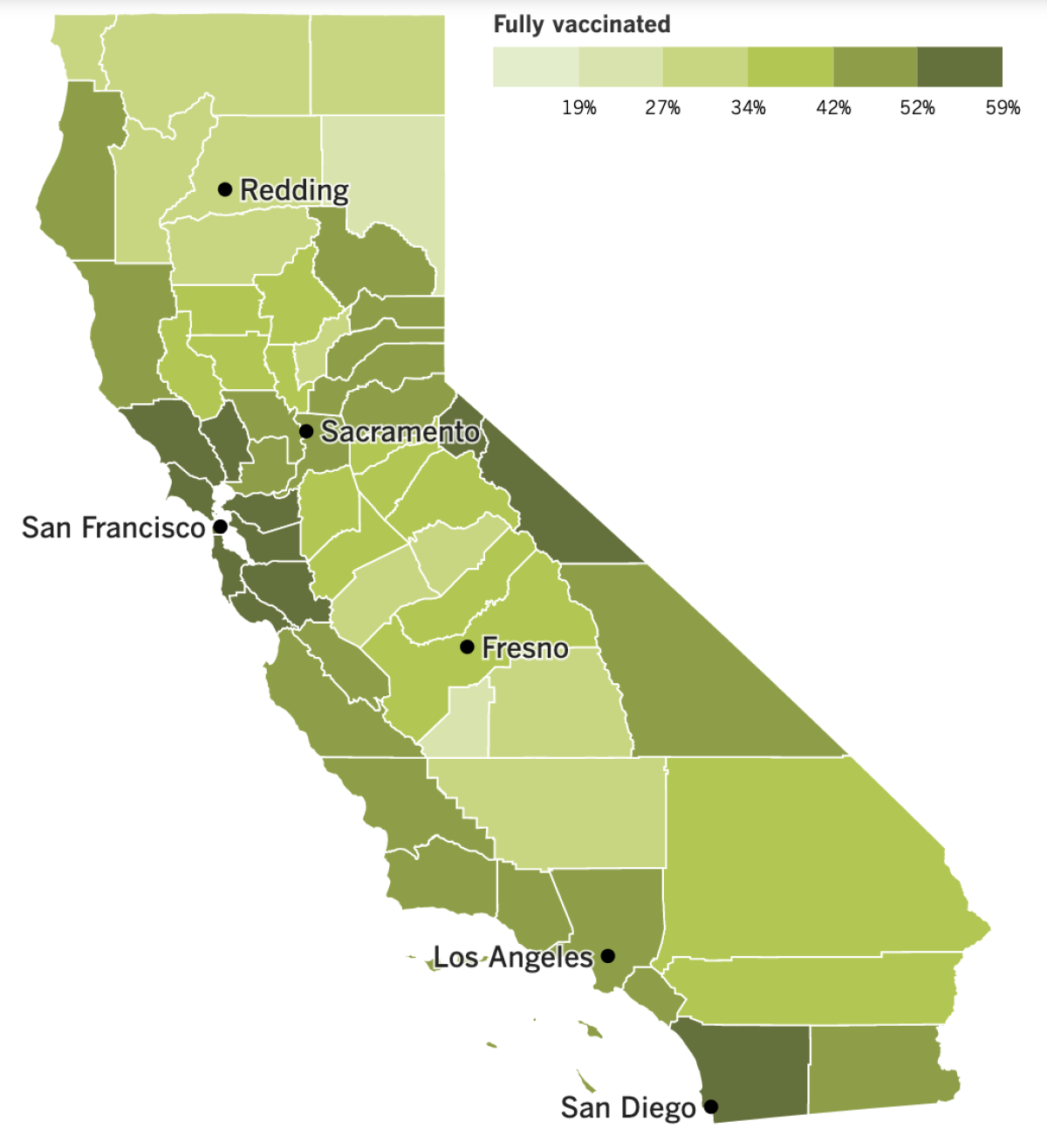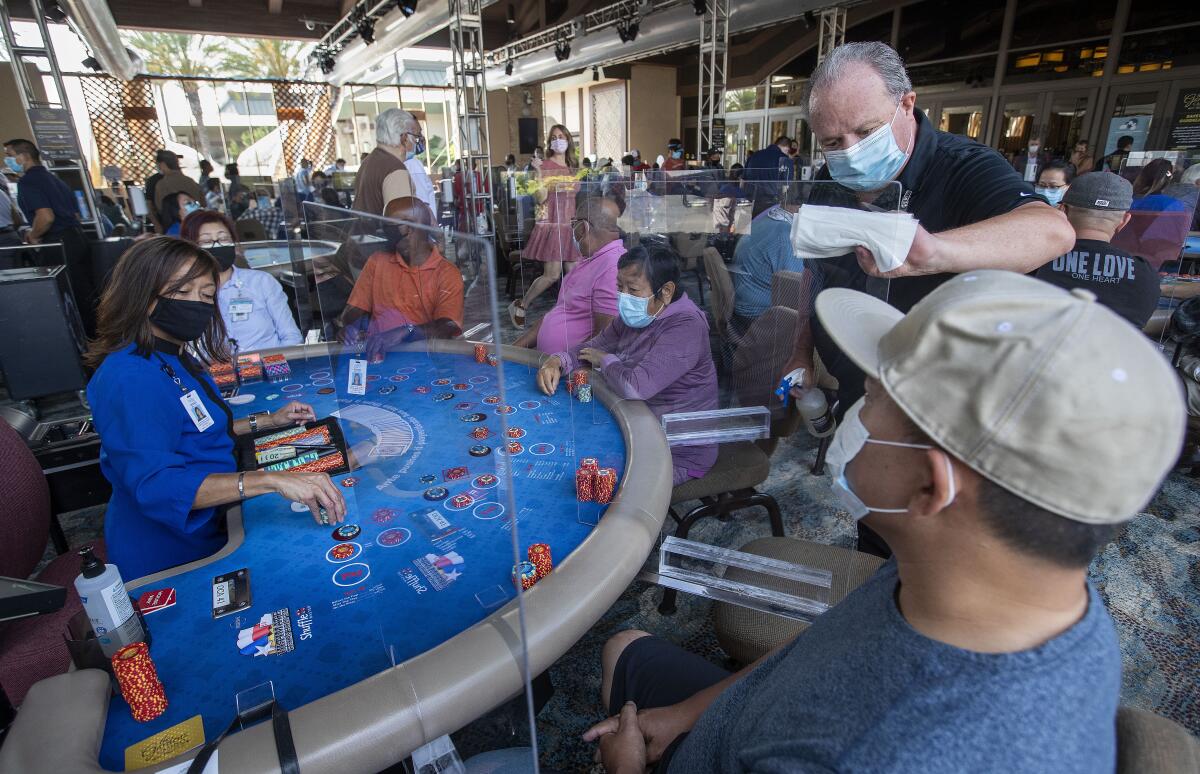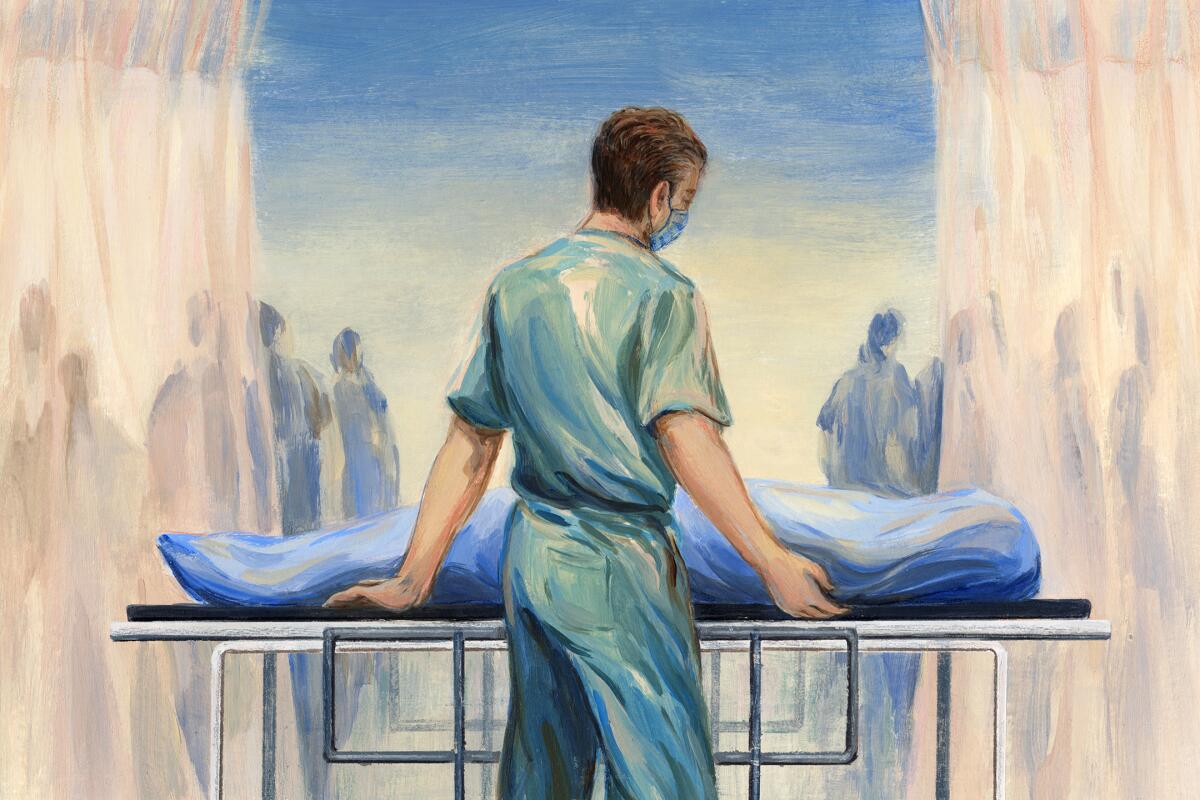Coronavirus Today: Second thoughts about rushing to vaccinate kids?
- Share via
Good evening. I’m Karen Kaplan, and it’s Friday, June 18. Here’s what’s happening with the coronavirus in California and beyond.
If there’s one thing experts have agreed on throughout the pandemic, it’s that the best way to end it is to create an effective COVID-19 vaccine (or several) and give it to people as quickly as possible. The sooner we deprive the coronavirus of potential victims, the sooner the outbreak will sputter to an end.
That’s why the Food and Drug Administration has issued emergency-use authorizations for three COVID-19 vaccines (so far) instead of waiting years for them to go through the normal approval process. That’s why President Biden has set a goal of delivering at least one dose of COVID-19 vaccine to 70% of Americans by the Fourth of July. That’s why the Centers for Disease Control and Prevention is updating its nationwide COVID-19 vaccine tracker on a daily basis. (We’re doing the same with vaccinations in California.)
But now some medical experts are beginning to challenge the idea that this full-steam-ahead vaccination strategy ought to apply to children. As my colleague Melissa Healy explains, their doubt isn’t fueled by anti-vaccination conspiracy theories. Rather, they’re recalculating the balance of risks and benefits in light of reports of heart problems in newly vaccinated adolescents.
In the weeks since the FDA authorized the Pfizer-BioNTech COVID-19 vaccine for emergency use in adolescents as young as 12 on May 10, the government’s safety monitoring systems have detected dozens of cases of myocarditis, an inflammation of the heart muscle. The cases typically developed in older adolescents, usually boys, three or four days after their second dose. Virtually all the cases were mild, were treated with over-the-counter medications and resolved without causing serious cardiac malfunction.
It’s not clear whether myocarditis is a side effect of the vaccine or if the onset of the heart problems so soon after vaccination was simply a coincidence. Experts are still digging into the data, but Dr. Tom Shimabukuro, deputy director of the CDC’s Immunization Safety Office, said that as of June 10, the number of cases of myocarditis (and a related condition called pericarditis) in people younger than 30 was more than double what they’d normally expect.
The Pfizer-BioNTech vaccine has been administered safely to millions of adults, and it was vetted in a few thousand teens. But because of the public health emergency, it was not subjected to the kind of exhaustive testing in a diverse population of kids that’s typically required for any vaccine intended for universal use in kids. (The same goes for the Moderna vaccine, which is now under consideration for emergency-use authorization in kids as young as 12.)
To be clear, no one is arguing that kids shouldn’t get vaccinated against COVID-19. But some are questioning the need to move ahead so quickly, using the same two-dose regimen that was designed for adults.
After contending with the coronavirus for more than a year, it’s clear that children are less likely than adults to become severely ill or to die of COVID-19. Nor do they seem to spread the virus as efficiently as adults. With those things in mind — plus the fact that the pandemic appears to be winding down in the U.S. — there’s time to slow down and weigh the risks and benefits for kids more carefully, argues Dr. Martin Makary, a public health expert at Johns Hopkins University.
“But no one is thinking like this,” he said. “We’ve converted now from being pro-vaccine to vaccine fanaticism.”

Makary isn’t the only one having second thoughts about the rush to vaccinate children. Experts will debate the significance of the myocarditis cases — and the possibility of other as-yet-unknown safety threats — at next week’s meeting of the CDC’s Advisory Committee on Immunization Practices.
Some people, like Dr. Jodie Votava-Smith, remain eager to get kids vaccinated as soon as they’re eligible. A pediatric cardiologist at Children’s Hospital Los Angeles, she has treated a patient who developed myocarditis after a dose of vaccine. (The patient’s case was mild, and ibuprofen did the trick.)
She’s also treated dozens of children who’ve developed serious heart muscle inflammation because of COVID-19. These children were severely ill and now face potentially enduring health effects. The disease was the cause of their misery, she said, not the vaccine.
Votova-Smith’s own children, ages 5 and 7, are still too young to get vaccinated, but she said she “can’t wait” for that day to come. “They know they’ll be getting their shot when it’s their turn,” she said.
By the numbers
California cases, deaths and vaccinations as of 4:27 p.m. Friday:

Track California’s coronavirus spread and vaccination efforts — including the latest numbers and how they break down — with our graphics.
How the pandemic is changing our economic lives
There’s plenty about the last year-plus we’ll be happy to forget, but some of our pandemic proclivities will stick with us. That includes our relationship with money — what we’re willing to do to get it, and how we prefer to spend it.
Let’s start with the latter. Online shopping was hardly a novelty before the pandemic, but when ordered to stay at home, consumers went online and ordered items they’d never put in a virtual cart before. For instance, Instacart, the grocery delivery company founded in 2012, finally turned its first profit in April 2020. Sales have fallen since then but are still four times what they were before the pandemic.
Curbside pickup at eateries and third-party delivery services such as DoorDash and Postmates were around before the pandemic as well, but they got a huge boost when restaurant dining was verboten. Even with dining rooms open again, analysts and restaurateurs expect these to-go options to make up a larger share of their sales going forward.
The coronavirus also turned many of us into novice bartenders. Unable to head to our favorite watering holes, Californians started spending more on gin, scotch, tequila and other spirits at grocery and liquor stores. Sales of wine and beer rose as well, though not by quite as much. Bars are open again, but store sales of alcohol remain higher than they were before the pandemic.
The lockdown realigned our spending on entertainment, with one survey finding that 56% of consumers signed up for at least one new subscription streaming service. Netflix now has more than 300 competitors, including streamers for horror fans, film buffs, Christians and pretty much any other niche you can think of. Analysts are starting to pick up on “subscription fatigue,” but with more than two-thirds of those survey respondents saying they plan to keep spending more time consuming entertainment, these viewing habits are probably here to stay.
Some people will find themselves with lots of time to watch movies, because this has become the summer of quitting your job.
It may seem hard to believe after the pandemic stole so many livelihoods, but more than 3.9 million people quit their jobs in April, according to the Bureau of Labor Statistics. That’s the highest quit rate — the ratio of people quitting their jobs to total employment — since the agency began tracking those figures in 2000.
The quitters come from high-turnover industries such as retail, warehousing and food service, as well as from professional and business services. To some extent, they’re making up for lost time, since nearly 6 million fewer people walked away from their jobs in 2020 than did in 2019. Anthony Klotz, a management expert who has researched the psychology of quitting, says workers were “sheltering in place” last year while the pandemic rocked the global economy.
But there’s more to it than that, Klotz told my colleague Sam Dean. After a year of unprecedented stress, burned-out workers have reexamined their lives and set new priorities: “We all want to pursue life, liberty and happiness, and many of us have realized our job isn’t the best way to get there.”
Krystine Altamirano, a 28-year-old who works in accounting at a private equity firm, expected to have a long career in finance. Then the pandemic prompted her to rethink everything. She recently gave notice and plans to switch to a career she finds more meaningful, perhaps in education.
“Life shouldn’t be so stressful all the time,” she said. “Capitalism has just gotten more and more detrimental to people’s mental health.”
In many cases, employees came to appreciate how working from home improved their work-life balance, and they’re not willing to give up that flexibility by returning to their offices full time. If their bosses aren’t on board with that, they’ll leave.
And they may be surprised by their options. Job postings hit a record high in April, with the number of open positions exceeding the number of unemployed workers by 695,000.
Payrolls in California alone grew by more than 100,000 jobs in May, the fourth consecutive month this feat was achieved. Jobs are returning at a faster rate than in any previous recovery, though there’s still a ways to go: Only slightly more than half the 2.7 million jobs lost at the beginning of the pandemic had returned as of last month.
“We are emerging from the scourge of COVID-19,” said Lynn Reaser, an economist at Point Loma Nazarene University. “With California’s economy fully open as of June 15, job prospects for the rest of the year are very strong.”


Consider subscribing to the Los Angeles Times
Your support helps us deliver the news that matters most. Become a subscriber.
In other news
California has said it won’t implement a vaccine passport system, but on Friday the state unveiled a new system that allows residents to access a digital copy of their COVID-19 vaccination record.
The electronic option is meant to be a handy alternative to the white paper cards with the CDC logo that are given out when you get your shot.
Californians can request their not-quite-a-vaccine-passport online at myvaccinerecord.cdph.ca.gov by entering their name, date of birth and the email address or cellphone number they used to sign up for their shots. If everything works, they’ll end up with their inoculation record and a scannable QR code.
But if any of that information was entered into the state’s immunization registry systems incorrectly, you can get help by calling the COVID-19 hotline at (833) 422-4255 or using the virtual assistant at cdph.ca.gov/covidvaccinerecord. (Fair warning: The troubleshooting system was overwhelmed on Day One, freezing people out in the middle of their sessions.)
Elsewhere in state government, Gov. Gavin Newsom signed an executive order Thursday with new rules for returning to the office. The guidance, which was approved by the Occupational Safety and Health Standards Board, allows fully vaccinated employees in most workplaces to stop wearing masks on the job.
If workers want to ditch their masks, employers will have to verify that those workers are fully vaccinated. The verification process can be as simple asking workers whether they got their shots, and there’s no requirement for employers to keep paper records.
Certain exceptions remain. Everyone in a healthcare or long-term care facility, K-12 school, child-care center, transportation hub, homeless shelter, emergency center or cooling center, prison, jail or other detention center must wear a mask. That includes vaccinated workers.
Unvaccinated workers can remove their masks indoors only if they’re alone or if they’re eating or drinking. Otherwise they’ll need to mask up. Employers will have to provide masks to workers who aren’t fully vaccinated, including an N95 mask if requested.
The new standards do away with requirements for solid, cleanable partitions that were designed to reduce viral transmission. That means the plexiglass barriers like the ones that separate cashiers from customers can come down.

In the nation’s capital, a push is underway to launch a full-blown investigation of the coronavirus crisis by a national commission like the one that looked into 9/11.
Democratic Sen. Robert Menendez of New Jersey and Republican Sen. Susan Collins of Maine have introduced a bill that would establish such a commission. If the measure succeeds, the inquiry could include an investigation into the origins of the virus; the degree of coordination among federal, state and local agencies; the use of testing and other forms of public health surveillance; and the availability (or lack thereof) of medical supplies, among other things.
No vote on the bill is scheduled and its prospects are uncertain, but a privately sponsored team of public health experts is already laying the groundwork. The COVID Commission Planning Group has been at work for five months, trying to come up with the key questions for a commission and the best ways to get answers.
One question many people are asking is what will happen if the Delta variant from India builds itself up while millions of Americans balk at getting vaccinated. The vaccines currently being used in the U.S. are effective against the variant, but states with lower vaccination rates would still be vulnerable.
The Delta variant is spreading fast. It accounted for 2.7% of all cases last month; this month, that figure jumped to 9.7%, according to CDC Director Dr. Rochelle Walensky.
Previously hard-hit states such as California and New York reopened their economies this week, but others have seen cases and hospitalizations rise sharply. States are using focus groups to get a better understanding of who is still resistant to COVID-19 vaccines and what can be done to change their minds.
“It’s a race between the vaccines going into people and the current or future variants,” Kansas Health Secretary Dr. Lee Norman said.
Luckily, the U.S. government has decided to invest $3.2 billion in a program aimed at speeding the development of antiviral pills to treat COVID-19 and other diseases that could turn into pandemics.
The U.S. has approved one antiviral drug, remdesivir, specifically for COVID-19, and allowed emergency use of three antibody combinations that help the immune system fight the virus. But all the drugs have to be given by IV at hospitals or medical clinics, and health experts would rather have a pill that patients could take themselves when symptoms first appear.
Some drugmakers are testing such medications, but initial results aren’t expected for several more months. The new funds will speed those tests and support private sector research, development and manufacturing.
Wanna get away? As of Friday, the European Union is welcoming Americans back across the pond.
The EU formally recommended that its 27 member states lift their ban on nonessential travel from the United States, though it’s up to each country to decide on its own rules for visitors. Germany quickly said it would allow Americans to enter if they are vaccinated or test negative for the coronavirus, while southern European nations like Spain are advocating maximum mobility.
The action in Europe may soften the blow for those who’ve been eager to travel to Canada. Officials there said Friday that border restrictions on nonessential travel will be extended until July 21.
The move is intended to give our neighbors to the north more time to get vaccinated before opening up to tourists. Only 20% of Canadians are fully vaccinated, compared with nearly 45% of Americans.
Your questions answered
Today’s question comes from readers who want to know: What’s the etiquette for interacting with workers when I go into a store or restaurant?
The answer to this question is bound to change over time as we collectively become more comfortable resuming our pre-pandemic habits. In these early days of the state’s reopening, it would be polite to consider the feelings of the front-line workers you encounter.
And we know how they feel because my colleagues in the Business section went out and asked them. Here are some of the key take-aways:
• If you’re fully vaccinated, feel free to let workers know. It might seem like a flex, but it’s actually a way to put those around you at ease. “It would make everyone more comfortable,” said Kathryn Lundeen, who owns a gift shop in Culver City.
• Mask up when you can. Even in cases where it’s not required, covering your nose and mouth will give those around you one less reason to worry. “If you’re not eating, if you’re just hanging out and chatting with somebody, it would be nice to have people put their masks back on,” said Ricky Hernandez, proprietor of Coffee Coffee in Los Angeles.
• Skip the chit-chat. It’s not just coughs and sneezes that spread the coronavirus — a person who’s infected can expel tiny viral particles when they speak. (The same goes for singing, though serenading the supermarket checker is not advised for other reasons.) Pamela Hill, a cashier at an Albertsons supermarket in South Los Angeles, wants you to know that her curtness stems from a desire to protect herself and her family. “I just want to get them in and get them out,” she said of her customers.
• Respect the rules of the business you’re patronizing, even if they’re stricter than required by law. It may come as a shock, but workers don’t like it when customers who are asked to wear a mask respond by screaming at them or calling them “libtards.” It was bad enough when businesses were simply following the rules set forth by the county health department. Now folks like Tohm Infergan are bracing for more conflict. “There’s a subtle fear that if we want to continue to do things that make us feel more comfortable, it’s only going to cause more challenging interactions,” said the owner of the Dayglow coffee shops in Silver Lake and West Hollywood.
We want to hear from you. Email us your coronavirus questions, and we’ll do our best to answer them. Wondering if your question’s already been answered? Check out our archive here.
The pandemic in pictures

This illustration is of a man named Karl, a member of the dispatch department at Loma Linda University Medical Center. His job involves wheeling patients from hospital rooms to CT scanners, delivering specimens to labs and moving supplies and medications. During the pandemic, too much of his job involved transporting COVID-19 victims to the hospital morgue.
Karl often blends into the background at the busy medical center, but his quietly respectful actions attracted the attention of Dr. Courtney Martin, an obstetrician there. She talked to him and learned what went through his mind as he collected all those bodies. Here’s some of what she wrote:
He said he was kept going during all of it because he felt like, when all the dust settled, the monitors were turned off, the family left, the sheet pulled over the face of a former life, that someone needed to make sure they still got care.
Someone needed to make sure they were put on the metal gurney nicely, arms positioned comfortably, feet and legs covered.
Someone needed to take them down to the morgue with dignity and care. Someone needed to escort them, go with them.
Someone needed to be their guardian.
You can read Maria La Ganga’s moving story about Karl — a private man who didn’t want his picture taken for the story — here, and Martin’s full essay here.
Resources
Need a vaccine? Sign up for email updates, and make an appointment where you live: City of Los Angeles | Los Angeles County | Kern County | Orange County | Riverside County | San Bernardino County | San Diego County | San Luis Obispo County | Santa Barbara County | Ventura County
Need more vaccine help? Talk to your healthcare provider. Call the state’s COVID-19 hotline at (833) 422-4255. And consult our county-by-county guides to getting vaccinated.
Practice social distancing using these tips, and wear a mask or two.
Watch for symptoms such as fever, cough, shortness of breath, chills, shaking with chills, muscle pain, headache, sore throat and loss of taste or smell. Here’s what to look for and when.
Need to get tested? Here’s where you can in L.A. County and around California.
Americans are hurting in many ways. We have advice for helping kids cope, resources for people experiencing domestic abuse and a newsletter to help you make ends meet.
We’ve answered hundreds of readers’ questions. Explore them in our archive here.
For our most up-to-date coverage, visit our homepage and our Health section, get our breaking news alerts, and follow us on Twitter and Instagram.




